Monday, January 20 2014
As most MIPS members already know, we show several possible trading profiles for our MIPS models under the "Services" tab on our main menu at www.mipstiming.com (and more under the "Trading Profiles" button on the Services page).
Also, I have said many times that you can trade any ETF that "correlates" well with the SPY (from Investopedia => http://www.investopedia.com/terms/c/correlation.asp ). Trading SPY/SH is the most conservative trading profile for our long/short MIPS models. However, we will show and will expand upon, more aggressive trading profiles herein.
For aggressive investors, we recommend trading a "mix" of ETFs, like 1/3 each of SPY, IWM, SSO or 1/4 each of SPY, IWM, QQQ, SSO on long signals and their respective inverse ETFs on short signals (SH, RWM, PSQ, SH*, where *SH is the single leverage inverse fund for SPY because we do not like double leverage on shorts).
See, for example, the results below from trading 1/3 each of SPY/SH, IWM/RWM, SSO/SH long/short:
BTW, on short signals, remember that your options are: (a) 1/3 each of SH, IWM, SH as in #1 below, or (b) 50% each of SH and RWM, or (c) 100% RWM, or (d) 100% SH.
I.) MIPS4/MF+ Trading SPY/SH from 2007-2013
CAGR since Jan'07 SPY=+6.1% vs. MIPS=+31.3% Max Drawdown= -10.6%
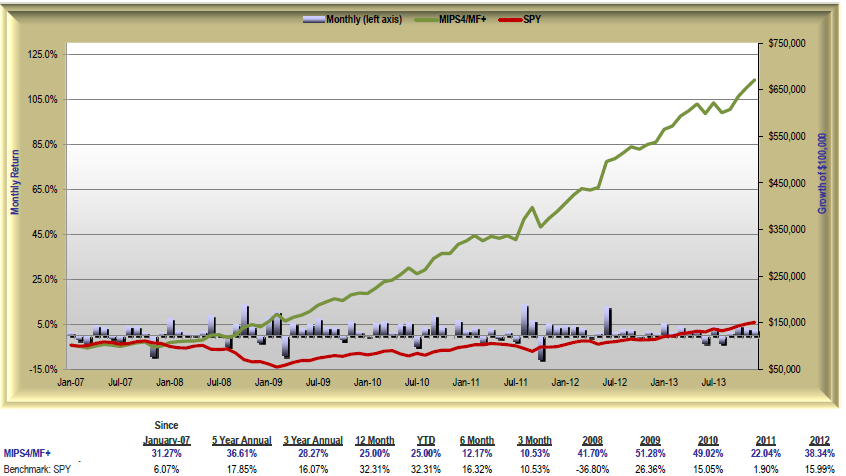
II.) MIPS4/MF+ Trading IWM/RWM from 2007-2013
CAGR since Jan'07 SPY=+6.1% vs. MIPS=+36.9% Max Drawdown= -15.1%
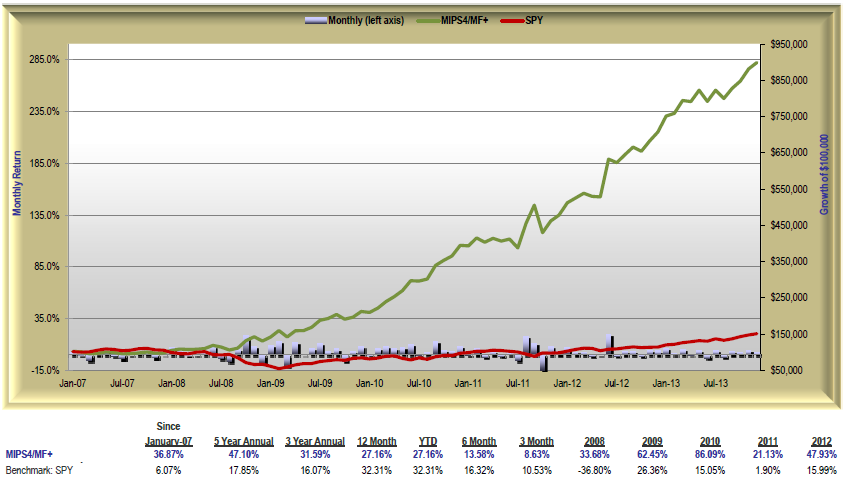
III.) MIPS4/MF+ Trading SSO/SH from 2007-2013
CAGR since Jan'07 SPY=+6.1% vs. MIPS=+52.7%, Max Drawdown= -16.1%
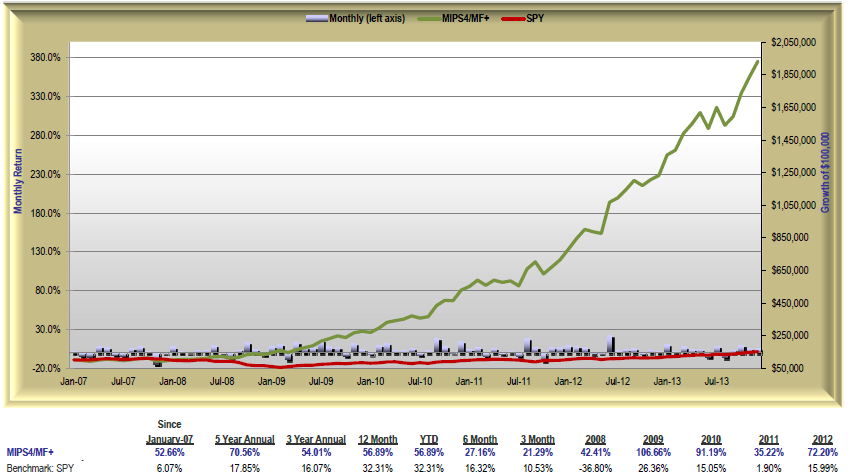
Good "mixing" to all !!!
Monday, January 20 2014
Was the market up or down in the last 4 weeks? Neither. The market (SPY) has been up and down in the last 4 weeks, three times each. The net effect was the SPY bouncing at plus and minus 0.8% around the "mean line" of about $183.36/share. Not very exciting. See the graph below.
Of course, this will not go on forever, and the SPY will once again break out of this most recent sideways trading pattern. My bet is to the upside, but no one can be sure about that. With QE3 alive and well under Yellen, being long is most likely a very good bet.
However, many indicators (both fundamental and technical) are signaling the high probability of a "correction" of at least 5-20% in 2014, but who really knows. What we can be sure of is that one day the market will take a dive that could result in another big "crash". But when? Don't know, and that is why we use MIPS.
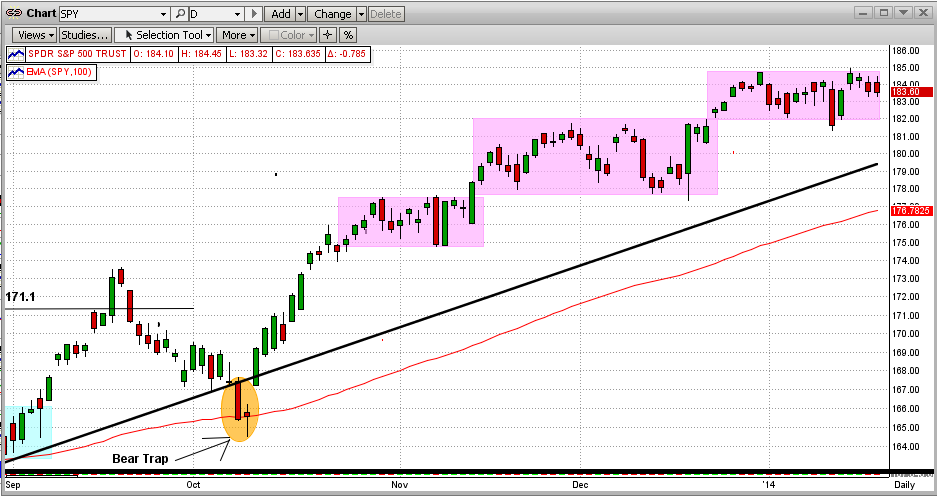
Tuesday, January 07 2014
I would like to examine the graph below from two different perspectives. One is from the MIPS viewpoint and the other is from the perspective of how the stock market behaves at the very end of one year and the beginning of the next. The second perspective has nothing to do with the MIPS models, but it is still very interesting because it does the same thing almost every year.
First, from the MIPS viewpoint, the graph below shows the third flat/sideways trading pattern for the SPY since the end of October 2013. In general, these sideways patterns will break out in the direction that they went in (all of the last three from the upside). The MIPS models called all of these correctly and stayed long. At this point, there is no indication of which way the SPY will break out of this new sideways trading pattern, but the odds are to the upside at this point (but, we all know that this can change in a matter of days).
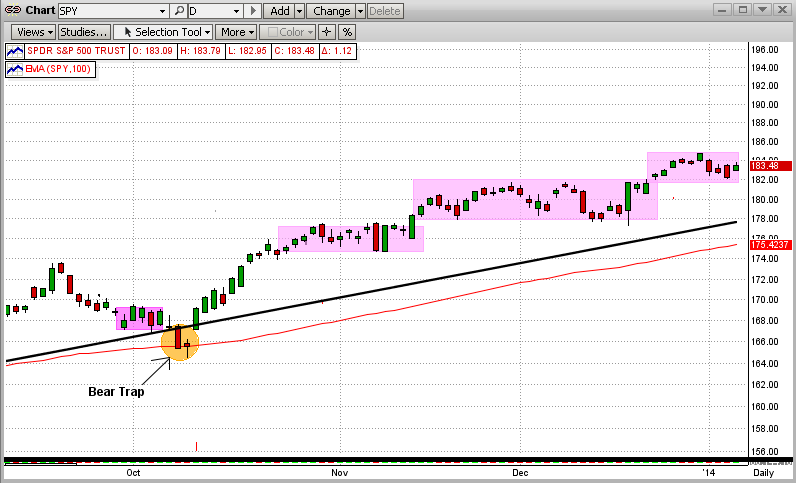
Secondly, from the viewpoint of market behavior, the following phenomenon repeats time and time again.
1) The "Santa Claus Rally" is obviously a rally at the end of December. Many people feel that a major reason for this is that mutual funds buy "winners" in late December to include in their current year-end portfolio to make it appear as though they have owned these winners all year (and hence they show a portfolio of winners). This December, the SPY was up for the last seven trading days.
2) The "January Effect" is the belief (and subsequent behavior) that year-end bonuses are mostly paid in January, which leads to heavier individual buying, thus pushing the market higher. It usually works this way unless some unexpected bad news develops. However, the first few days of every January have a tendency to be down as investors dump their last-year winners to (a) protect their profits and (b) take their gains in the current year instead of in the prior year for tax reasons.
3) Watch for what is called the "January Barometer". This term results from the fact that statistically, the market performance in any given year mimics the market performance in January of that year. For example, if the market is up in January of any given year, there is roughly a 90% chance that the market will be up for that year (and vice versa, of course). This statistic is from the years 1950-2013. The saying for this is "As goes January, so goes the rest of the year".
Blog from 12/29/2013
In our previous blog below from 12/22/13, we showed how the SPY had climbed quickly back to the top of its flat/sideways trading pattern on high volume. From this one could conclude that we should have expected a "breakout" to the upside this past week. As can be seen in the graph immediately below, we did get an upside breakout this past week, but not what we would call a really strong breakout. This is mainly because of its low volume. The odds are for this breakout to pick up steam and head higher, but it could very easily turn out to be a "bull trap" that turns lower in the short term. It is exactly these kinds of situations when we need for MIPS to tell us what to do.
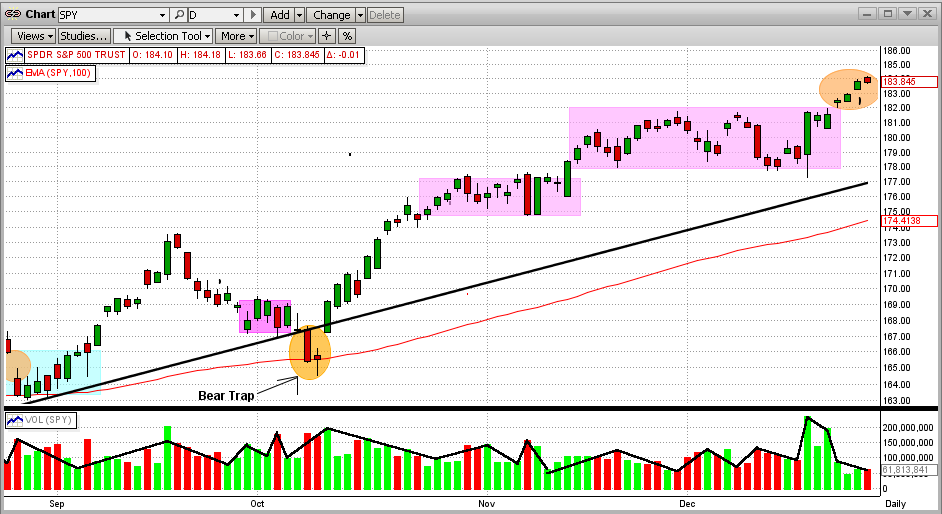
Blog from 12/22/2013
In our previous blog (from 12/16/13), we told our MIPS members to basically ignore the 5-consecutive-day drop in the SPY that occurred in the previous week (see the last graph below). The reasons for this were: (a) the entire drop was just a little over 2% and (b) the market was just completing a drop from the top to the bottom of a relatively flat/sideways 15-day trading pattern.
Then this last week, the SPY basically reversed it movement and simply went back to the top of the trading pattern (see graph immediately below). No breakout. So, is this week's move up any different than last week's move down? In many cases, the answer would be no. But, there are some compelling reasons for believing that the recent move up was indeed more telling than the previous move down, even though there was no breakout. One reason is that the trading pattern is now over 20 days old, and sideways trading patterns usually do not last much longer than that. But the BIG reason to think that this move up is different from the prior moves is that the move up was on volume almost two time higher than the volume for the prior 30 days. Thus, one can conclude that the move up was the result of the big guys buying. That's huge!!!
The real story will most likely unfold within the next week or two, so let's stay long and wait for MIPS to tell us what to do next.
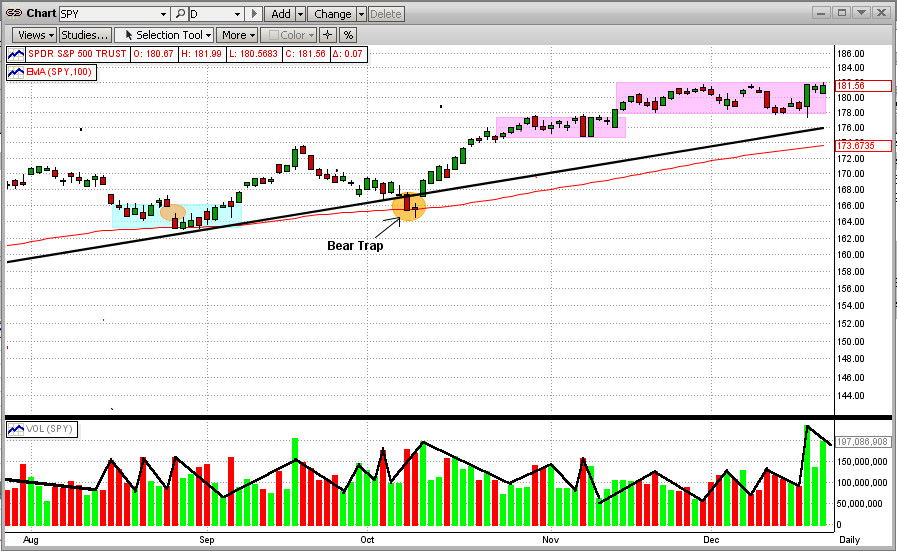
Sunday, December 29 2013
In our previous blog below from 12/22/13, we showed how the SPY had climbed quickly back to the top of its flat/sideways trading pattern on high volume. From this one could conclude that we should have expected a "breakout" to the upside this past week. As can be seen in the graph immediately below, we did get an upside breakout this past week, but not what we would call a really strong breakout. This is mainly because of its low volume. The odds are for this breakout to pick up steam and head higher, but it could very easily turn out to be a "bull trap" that turns lower in the short term. It is exactly these kinds of situations when we need for MIPS to tell us what to do.

Blog from 12/22/2013
In our previous blog below (from 12/16/13), we told our MIPS members to basically ignore the 5-consecutive-day drop in the SPY that occurred in the previous week (see the last graph below). The reasons for this were: (a) the entire drop was just a little over 2% and (b) the market was just completing a drop from the top to the bottom of a relatively flat/sideways 15-day trading pattern.
Then this last week, the SPY basically reversed it movement and simply went back to the top of the trading pattern (see graph immediately below). No breakout. So, is this week's move up any different than last week's move down? In many cases, the answer would be no. But, there are some compelling reasons for believing that the recent move up was indeed more telling than the previous move down, even though there was no breakout. One reason is that the trading pattern is now over 20 days old, and sideways trading patterns usually do not last much longer than that. But the BIG reason to think that this move up is different from the prior moves is that the move up was on volume almost two time higher than the volume for the prior 30 days. Thus, one can conclude that the move up was the result of the big guys buying. That's huge!!!
The real story will most likely unfold within the next week or two, so let's stay long and wait for MIPS to tell us what to do next.

Sunday, December 22 2013
In our previous blog (from 12/16/13), we told our MIPS members to basically ignore the 5-consecutive-day drop in the SPY that occurred in the previous week (see the last graph below). The reasons for this were: (a) the entire drop was just a little over 2% and (b) the market was just completing a drop from the top to the bottom of a relatively flat/sideways 15-day trading pattern.
Then this last week, the SPY basically reversed its movement and simply went back to the top of the trading pattern (see graph immediately below). No breakout. So, is this week's move up any different than last week's move down? In many cases, the answer would be no. But, there are some compelling reasons for believing that the recent move up was indeed more telling than the previous move down, even though there was no breakout. One reason is that the trading pattern is now over 20 days old, and sideways trading patterns usually do not last much longer than that. But the BIG reason to think that this move up is different from the prior moves is that the move up was on volume almost two time higher than the volume for the prior 30 days. Thus, one can conclude that the move up was the result of the big guys buying. That's huge!!!
The real story will most likely unfold within the next week or two, so let's stay long and wait for MIPS to tell us what to do next.

Monday, December 16 2013
We at MIPS have always talked about and pointed out how the stock market moves in cycles. The MIPS models are designed to track intermediate-term cycles (like monthly cycles). But, of course, sometimes the market moves in "wiggles", not true cycles (e.g., really small day-by-day wiggles). Trying to trade wiggles leads one to much higher trading frequencies, and many times to getting whipsawed.
The last few weeks (and, in fact, several other times this year) are good examples of why one should not chase wiggles. See the graph immediately below. Looking at the market swings daily makes the changes look violent. We received many calls and emails from MIPS members last week asking what was going on in the market. Our response was "nothing that we should worry about, yet".
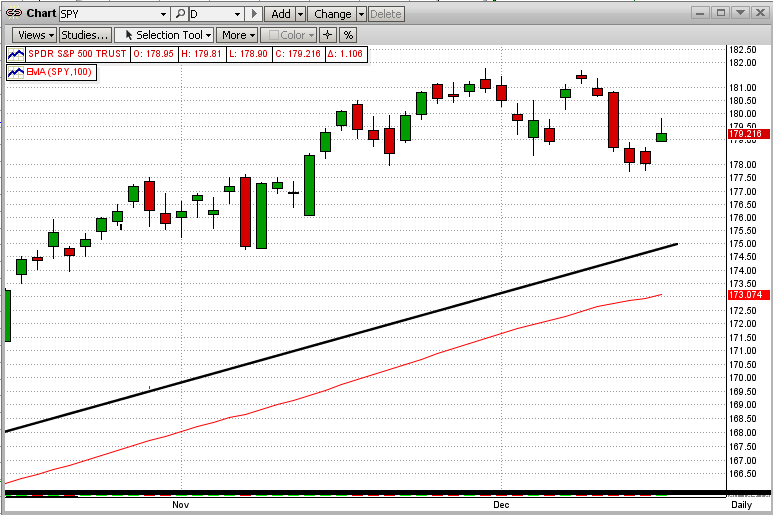
When we examine the market in the time frame that MIPS was designed to perform in the graph below, we now see a simple flat/sideways trading pattern, with the SPY trading plus and minus 1.13% around its mean-line value of $179.90/share. Now, that does not look so violent, and it is not violent in the context in which we are trading. These types of changes may be important to day traders that trade 5-10 times/day, but not to us. The moral of the story is for us to evaluate market moves in the context of our trading profile.
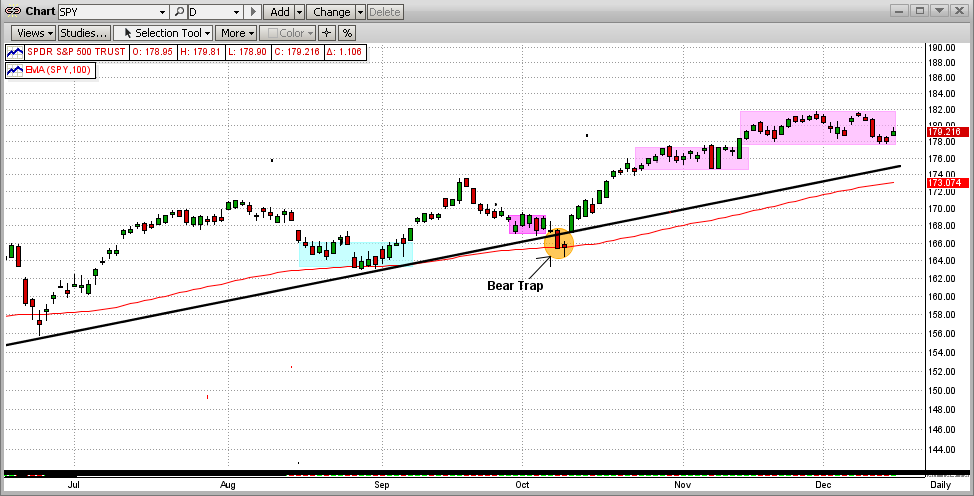
Which way the market moves from here is anybody's guess, and mine is that the market will move out of this sideways trading pattern (up or down) depending upon what the Fed says about its plans to "taper" pumping $85 billion/month in its bond-buying spree to keep interest rates artificially low. And, my guess is that the Fed will say it will not taper until 2014, and that will lift the markets. But remember, it is not what I think that matters, but what MIPS tells us.
Monday, November 25 2013
We have recently received several questions regarding the trading frequency of the MIPS models. Of course, the motivation for this is that the MIPS3/MF model has only traded twice in the last 12 months (and MIPS4/MF+ model has only traded 4 times in the same time period).
Over the last 11 years, these two MIPS models have traded an average of 10-15 times/year. But, what does that mean? It certainly does not mean that they trade once a month. A model that trades an average of 12 times/year can trade 2-4 times in some years and 18-20 times in others. And, when it does trade 12 times in one year, it can trade 3 times in one month and only once in the next 4-6 months.
The number one criteria that dictates the number of trades in any time period for a "trend following" model (like MIPS) is, of course, the time duration of the intermediate-term trends in said time period.
So, how does the above apply to MIPS3 and MIPS4 for 2013? To answer this question, let's look at the graph below of the SPY price action in the time frame of Nov'12 through Nov'13. In this graph, one can see the nearly perfect 12-month trendline of the SPY, and can hence understand why the MIPS3 and MIPS4 models have been long for the vast majority of this time period with very few trades. Remember, the MIPS models are following intermediate-term trends. A faster acting model would have tried to ride the shorter-term waves in the graph below, and would have traded much more often with no guarantee of better returns (but with a good chance of getting whipsawed).
SPY
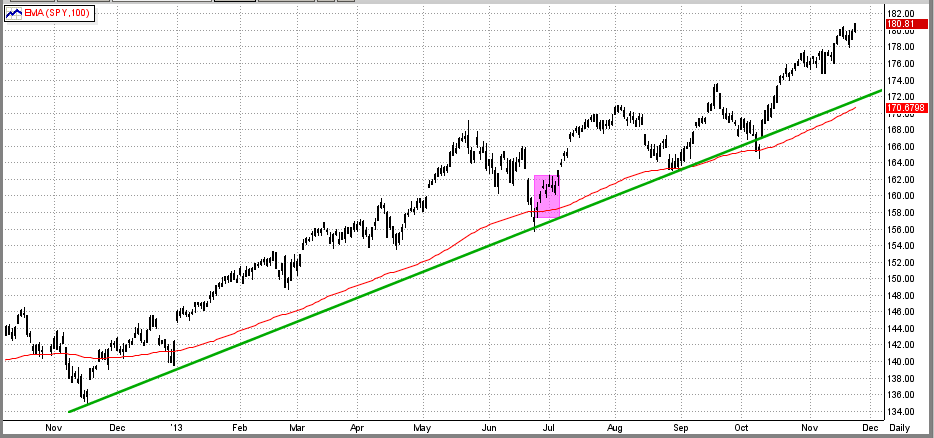
LAST 12 MONTH'S PERFORMANCE (all graphs from TimerTrac.com)
So, how did the MIPS3/MF model do in the last 12 months. We report most of our performance reports with MIPS trading the SPY long/short (or SPY long and SH short). But many of our MIPS members (including myself) trade "combos" like 1/4 each of SPY, IWM, QQQ, and SSO. See the performance of these ETFs below.
MIPS3 Trading SPY long/short

MIPS3 Trading IWM long/short
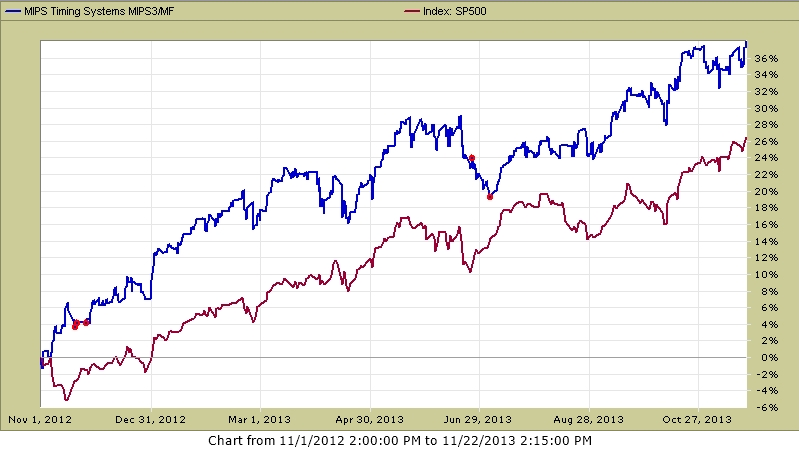
MIPS3 Trading QQQ long/short
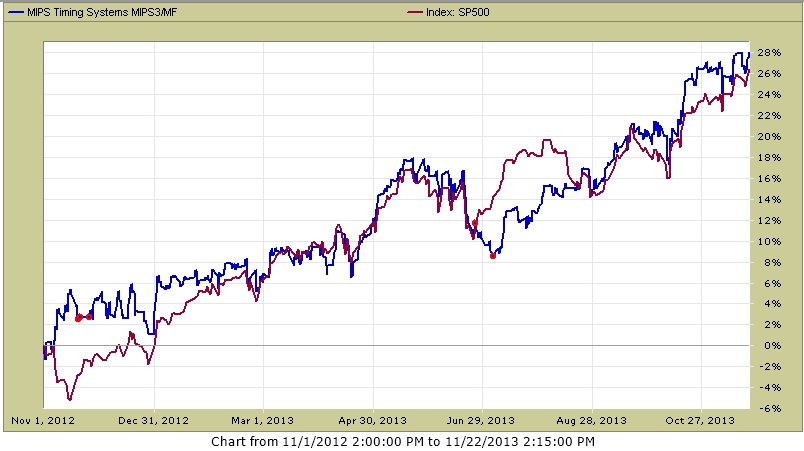
MIPS3 Trading SSO long and SH short
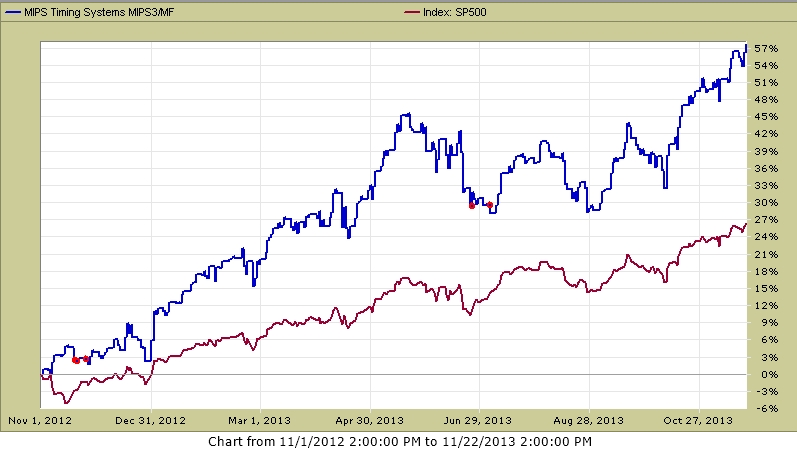
PAST BEHAVIOR
Please understand that a signal with a "life" of several months (not days) is normal behavior for the MIPS models. The models will follow the intermediate-term trends (up or down) for as long as these trends continue in the same direction. The red dots in the graph below show trades for the MIPS3 model during the time period of 2003-11/20/13. It can be seen that, in this time frame, there were at least 7 times in these 11 years when a trade signal lasted 4-6 months. And, you can see that ALL of them were winning trades (long and short).
MIPS3 Trading SPY long/short
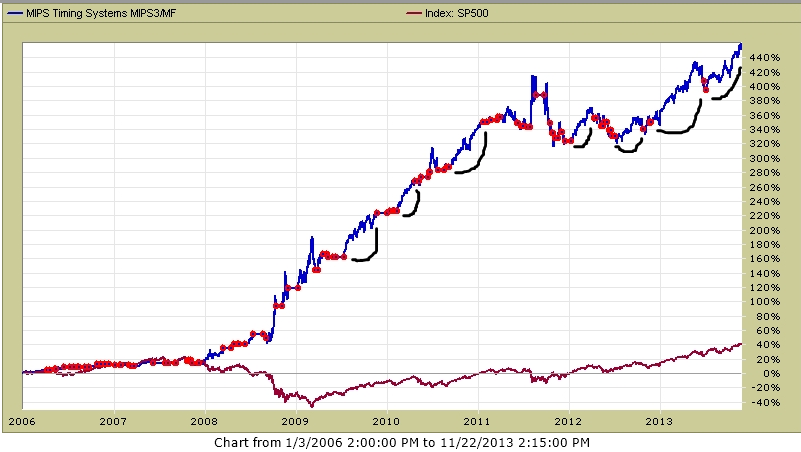
Thursday, November 14 2013
In a previous blog on April 8, 2103, we wrote about how the stock market is basically being controlled by (the actions of) one man - Ben Bernanke. This, of course, has everything to do with his printing more and more of your money, to the tune of $85 Billion every month (that's over $1 Trillion/year) !!! And, the Fed continues to do so. The point of the previous blog (and this one) was that it is very hard for the market to go down with this kind of money working to keep interest rates low. Remember the #1 rule in stock investing - "Don't fight the Fed." Of course, with low interest rates, money naturally funnels its way out of bonds and into stocks (and there is a lot of money in the bond market, like about 5 times that in the stock market).
At any rate, after trading in a tight sideways pattern for over 3 weeks, the SPY broke to the upside yesterday (Wednesday) and again today. See graph blow.
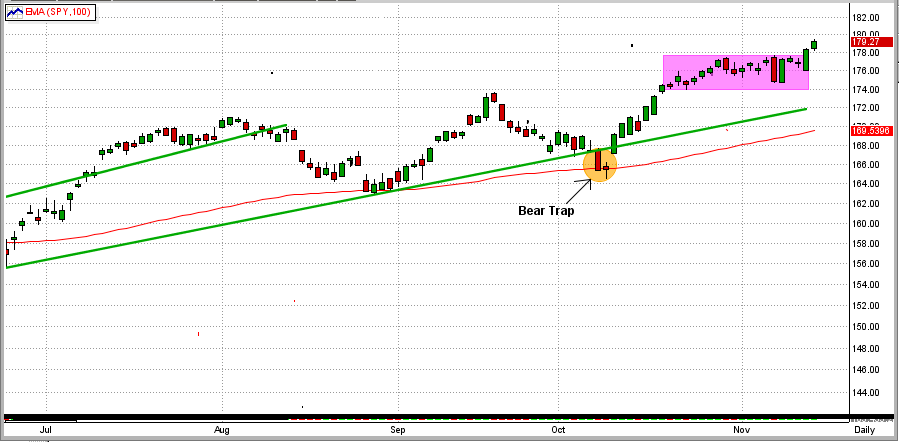
Also, as expected, the long-term upside trend continues from all the way back in November 2012 (see the long trend lines in the graph below). Again, this is no surprise with the Fed's extensive QE3 "program" (if you want to call it that). When (and if) this comes to an end, it most likely won't be pretty.
Of course, this long, relatively smooth up-trend is the reason that the MIPS models have not traded very often between late 2012 and thru Nov 14, 2013. We will wait for MIPS to tell us when the party is over.
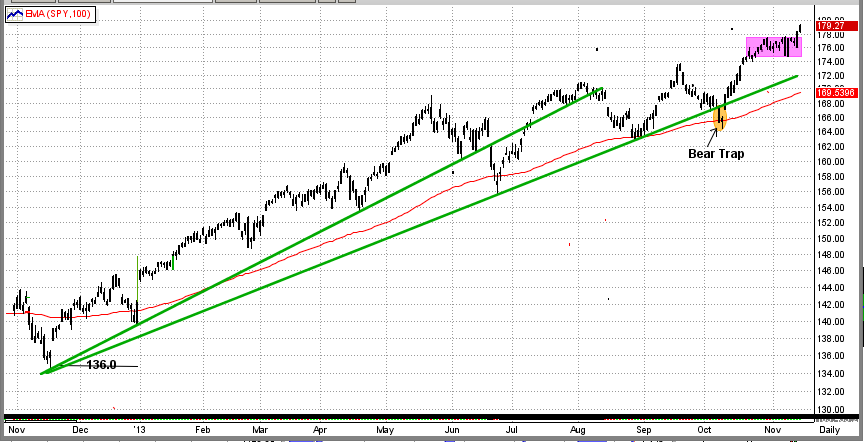
Sunday, November 03 2013
When trading double leverage ETFs (like for the SPY, IWM, QQQ, etc), we recommend:
(1) trading double leverage on long signals and single leverage on short signals, or
(2) simpy trading double leverage long only.
Here is how MIPS3/MF performed trading double leverage SPY (SSO) long only over the last 12 months.
SPY +23.4% SSO Long Only +50.5%
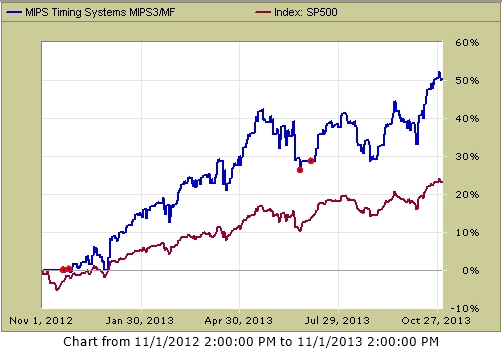
Friday, October 18 2013
Whether it is the sequester, Fed tapering, debt limit fiasco, etc., the market in 2013 has been volatile. But, it has remained mainly in an identifiable up-trend. During this time, however, the market has had enough major "dips" to drive some market timing systems crazy. But, the MIPS models have remained Long for almost the entire year.
The last several months have been illustrative of this, and show that the MIPS models have not gotten "fooled" into costly short signals. For example, the MIPS models have been long since 9/3/13 (after a 6-day, nondescript "short" on 8/27/13). In other words, the MIPS models have ignored the recent Bear Trap in the graph below by staying Long, and have, hence, "dodged a bullet".
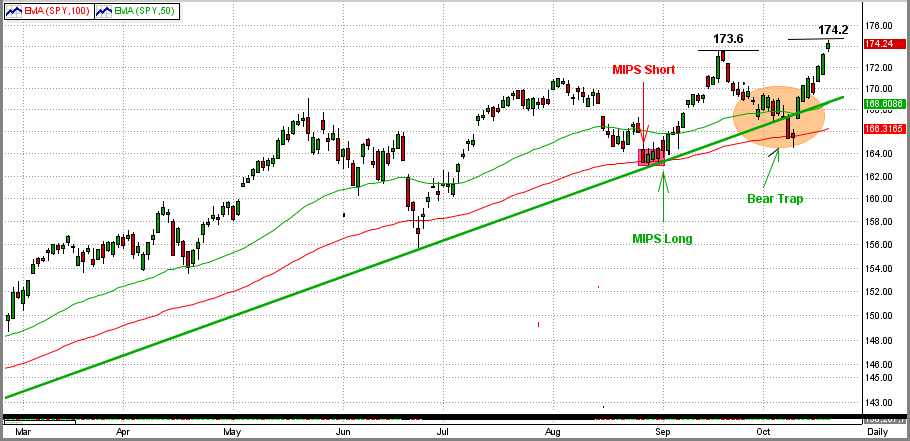
Many MIPS members are worried about the Market Crash of 2014, and wonder how MIPS will handle it.
Some timing systems have traded 15-25 times in 2013 and many have gotten whipsawed. In 2013, the MIPS models have been Long for the majority of the year, but are lagging the SPY by about 5%. Others have not traded at all and have "matched" the market. The problem with timing systems is that some do very well in up-markets and many of these do terribly in down markets, and vice-versa.
So, how does MIPS do in down markets? Our best example of this is in the year of 2008. The graph below shows the Long/Short/Cash Signals from our MIPS3/MF model in the time period 2008-3/20/09 (verified by TimerTrac).
Just how did MIPS3/MF handle the BIG market crash of 2008?
- well, it started with a short call on 12/12/07 for a 12% gain, followed by 4 other profitable short trades.
- for example, the total gain on the last 3 short trades between Sep'08-Mar'09 was about +40% !!!
This gives me great comfort and confidence in MIPS to get us out and to MAKE MONEY is the next CRASH !!
Legend: Red Box = Short Signals; Green = Long Signals; Yellow = Cash
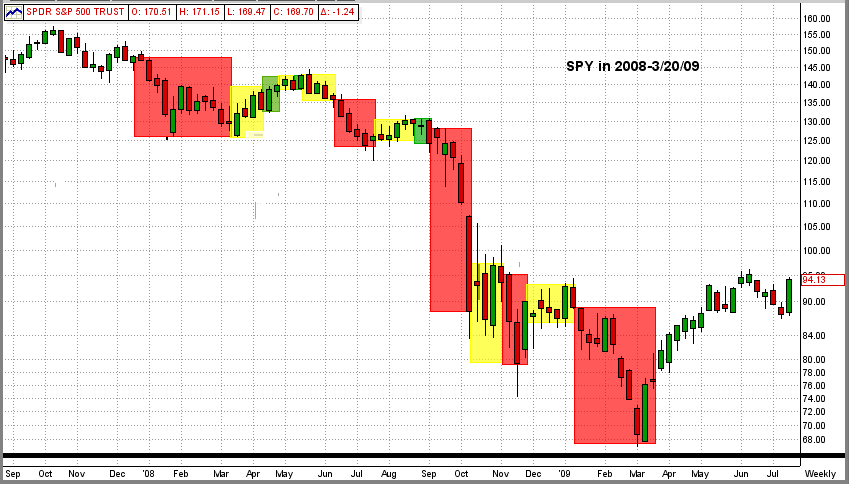
|